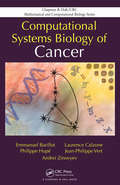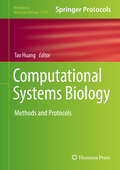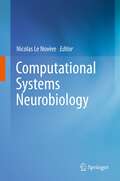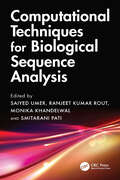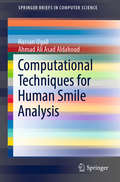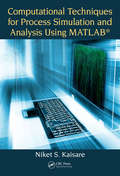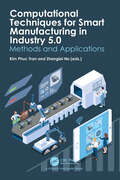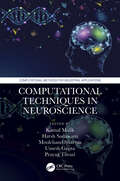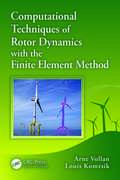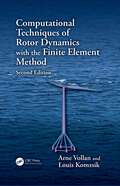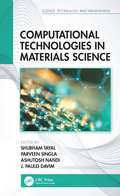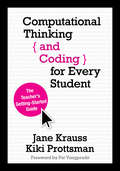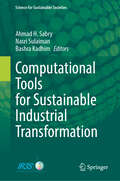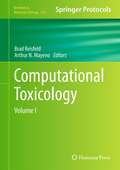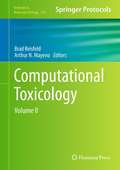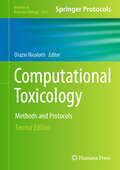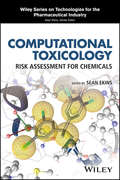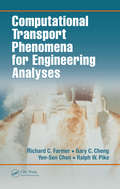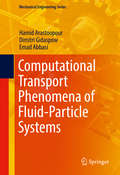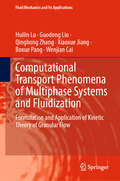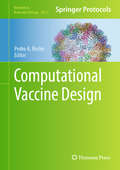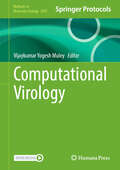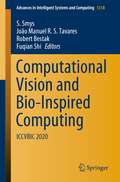- Table View
- List View
Computational Systems Biology of Cancer (Chapman & Hall/CRC Computational Biology Series)
by Emmanuel Barillot Laurence Calzone Philippe Hupe Jean-Philippe Vert Andrei ZinovyevThe future of cancer research and the development of new therapeutic strategies rely on our ability to convert biological and clinical questions into mathematical models-integrating our knowledge of tumour progression mechanisms with the tsunami of information brought by high-throughput technologies such as microarrays and next-generation sequencin
Computational Systems Biology: Methods And Protocols (Methods In Molecular Biology #1754)
by Tao HuangThis volume introduces the reader to the latest experimental and bioinformatics methods for DNA sequencing, RNA sequencing, cell-free tumour DNA sequencing, single cell sequencing, single-cell proteomics and metabolomics. Chapters detail advanced analysis methods, such as Genome-Wide Association Studies (GWAS), machine learning, reconstruction and analysis of gene regulatory networks and differential coexpression network analysis, and gave a practical guide for how to choose and use the right algorithm or software to handle specific high throughput data or multi-omics data. Written in the highly successful Methods in Molecular Biology series format, chapters include introductions to their respective topics, lists of the necessary materials and reagents, step-by-step, readily reproducible laboratory protocols, and tips on troubleshooting and avoiding known pitfalls.Authoritative and cutting-edge, Computational Systems Biology: Methods and Protocols aims to ensure successful results in the further study of this vital field.
Computational Systems Neurobiology
by N. Le NovèreComputational neurosciences and systems biology are among the main domains of life science research where mathematical modeling made a difference. This book introduces the many different types of computational studies one can develop to study neuronal systems. It is aimed at undergraduate students starting their research in computational neurobiology or more senior researchers who would like, or need, to move towards computational approaches. Based on their specific project, the readers would then move to one of the more specialized excellent textbooks available in the field. The first part of the book deals with molecular systems biology. Functional genomics is introduced through examples of transcriptomics and proteomics studies of neurobiological interest. Quantitative modelling of biochemical systems is presented in homogeneous compartments and using spatial descriptions. A second part deals with the various approaches to model single neuron physiology, and naturally moves to neuronal networks. A division is focused on the development of neurons and neuronal systems and the book closes on a series of methodological chapters. From the molecules to the organ, thinking at the level of systems is transforming biology and its impact on society. This book will help the reader to hop on the train directly in the tank engine.
Computational Techniques for Biological Sequence Analysis
by Ranjeet Kumar Rout Saiyed Umer Monika Khandelwal Smitarani PatiThis book provides an overview of basic and advanced computational techniques for analyzing and understanding protein, RNA, and DNA sequences. It covers effective computing techniques for DNA and protein classifications, evolutionary and sequence information analysis, evolutionary algorithms, and ensemble algorithms. Furthermore, the book reviews the role of machine learning techniques, artificial intelligence, ensemble learning, and sequence-based features in predicting post-translational modifications in proteins, DNA methylation, and mRNA methylation, along with their functional implications. The book also discusses the prediction of protein–protein and protein–DNA interactions, protein structure, and function using computational methods. It also presents techniques for quantitative analysis of protein–DNA interactions and protein methylation and their involvement in gene regulation. Additionally, the use of nature-inspired algorithms to gain insights into gene regulatory mechanisms and metabolic pathways in human diseases is explored. This book acts as a useful reference for bioinformaticians and computational biologists working in the fields of molecular biology, genomics, and bioinformatics.Key Features: Reviews machine learning techniques for DNA sequence classification and protein structure prediction Discusses genetic algorithms for analyzing multiple sequence alignments and predicting protein–protein interaction sites Explores computational methods for quantitative analysis of protein–DNA interactions Examine the role of nature-inspired algorithms in understanding the gene regulation and metabolic pathways Covers evolutionary algorithms and sequence-based features in predicting post-translational modifications
Computational Techniques for Human Smile Analysis (SpringerBriefs in Computer Science)
by Hassan Ugail Ahmad Ali AldahoudIn this book, the authors discuss the recent developments in computational techniques for automated non-invasive facial emotion detection and analysis with particular focus on the smile. By way of applications, they discuss how genuine and non-genuine smiles can be inferred, how gender is encoded in a smile and how it is possible to use the dynamics of a smile itself as a biometric feature. It is often said that the face is a window to the soul. Bearing a metaphor of this nature in mind, one might find it intriguing to understand, if any, how the physical, behavioural as well as emotional characteristics of a person could be decoded from the face itself. With the increasing deductive power of machine learning techniques, it is becoming plausible to address such questions through the development of appropriate computational frameworks. Though there are as many as over twenty five categories of emotions one could express, regardless of the ethnicity, gender or social class, across humanity, there exist six common emotions – namely happiness, sadness, surprise, fear, anger and disgust - all of which can be inferred from facial expressions. Of these facial expressions, the smile is the most prominent in social interactions. The smile bears important ramifications with beliefs such as it makes one more attractive, less stressful in upsetting situations and employers tending to promote people who smile often. Even pockets of scientific research appear to be forthcoming to validate such beliefs and claims, e.g. the smile intensity observed in photographs positively correlates with longevity, the ability to win a fight and whether a couple would stay married. Thus, it appears that many important personality traits are encoded in the smile itself. Therefore, the deployment of computer based algorithms for studying the human smiles in greater detail is a plausible avenue for which the authors have dedicated the discussions in this book.
Computational Techniques for Process Simulation and Analysis Using MATLAB®
by Niket S. KaisareMATLAB® has become one of the prominent languages used in research and industry and often described as "the language of technical computing". The focus of this book will be to highlight the use of MATLAB® in technical computing; or more specifically, in solving problems in Process Simulations. This book aims to bring a practical approach to expounding theories: both numerical aspects of stability and convergence, as well as linear and nonlinear analysis of systems. The book is divided into three parts which are laid out with a "Process Analysis" viewpoint. First part covers system dynamics followed by solution of linear and nonlinear equations, including Differential Algebraic Equations (DAE) while the last part covers function approximation and optimization. Intended to be an advanced level textbook for numerical methods, simulation and analysis of process systems and computational programming lab, it covers following key points • Comprehensive coverage of numerical analyses based on MATLAB for chemical process examples. • Includes analysis of transient behavior of chemical processes. • Discusses coding hygiene, process animation and GUI exclusively. • Treatment of process dynamics, linear stability, nonlinear analysis and function approximation through contemporary examples. • Focus on simulation using MATLAB to solve ODEs and PDEs that are frequently encountered in process systems.
Computational Techniques for Smart Manufacturing in Industry 5.0: Methods and Applications
by Zhenglei HeWe are witnessing rapid development in computational technologies and its applications in industry, leading to the 5th industrial revolution. Industry 5.0 is characterized by the synergies between machines and humans, with an aim to add value to production by creating personalized products able to meet customers' requirements. These intelligent manufacturing systems have been sought in various sectors (e.g. automobiles, power supplying, chemistry) to realize data-driven innovations for delivering highly customizable products and services faster, cheaper, better, and greener.This book presents recent advancements in research, new methods and techniques, and applications of advanced computational technologies in intelligent manufacturing for modeling, simulating, optimization, decision making, and other typical issues in manufacturing processes. It stimulates the scientific exchange of ideas and experiences in the field of intelligent manufacturing applications. Researchers and practitioners alike will benefit from this book to enhance their understanding of Industry 5.0, which focuses on combining human creativity and craftsmanship with the speed, productivity, and consistency of AI systems. Real-world case studies in various fields and practical applications are provided in each chapter.
Computational Techniques in Neuroscience (Computational Methods for Industrial Applications)
by Umesh Gupta Moolchand Sharma Prayag Tiwari Kamal Malik Harsh SadawartiThe text discusses the techniques of deep learning and machine learning in the field of neuroscience, engineering approaches to study the brain structure and dynamics, convolutional networks for fast, energy-efficient neuromorphic computing, and reinforcement learning in feedback control. It showcases case studies in neural data analysis. Features: Focuses on neuron modeling, development, and direction of neural circuits to explain perception, behavior, and biologically inspired intelligent agents for decision making Showcases important aspects such as human behavior prediction using smart technologies and understanding the modeling of nervous systems Discusses nature-inspired algorithms such as swarm intelligence, ant colony optimization, and multi-agent systems Presents information-theoretic, control-theoretic, and decision-theoretic approaches in neuroscience. Includes case studies in functional magnetic resonance imaging (fMRI) and neural data analysis This reference text addresses different applications of computational neuro-sciences using artificial intelligence, deep learning, and other machine learning techniques to fine-tune the models, thereby solving the real-life problems prominently. It will further discuss important topics such as neural rehabili-tation, brain-computer interfacing, neural control, neural system analysis, and neurobiologically inspired self-monitoring systems. It will serve as an ideal reference text for graduate students and academic researchers in the fields of electrical engineering, electronics and communication engineering, computer engineering, information technology, and biomedical engineering.
Computational Techniques of Rotor Dynamics with the Finite Element Method (Computational Techniques of Engineering)
by Arne Vollan Louis KomzsikFor more than a century, we have had a firm grasp on rotor dynamics involving rigid bodies with regular shapes, such as cylinders and shafts. However, to achieve an equally solid understanding of the rotational behavior of flexible bodies-especially those with irregular shapes, such as propeller and turbine blades-we require more modern tools and m
Computational Techniques of Rotor Dynamics with the Finite Element Method (Computational Techniques of Engineering)
by Arne Vollan Louis KomzsikRotor dynamics is both a classical and a modern branch of engineering science. The rotation of rigid bodies, mainly those with regular shapes such as cylinders and shafts, has been well understood for more than a century. However, analyzing the rotational behavior of flexible bodies, especially those with irregular shapes like propellers and blades, requires more modern tools such as finite elements, hence the title and focus of this book.In the dozen years since the original publication, this book was used in teaching engineering students at universities and in consulting in the industry. During those activities, several topics were deemed to require further explanations. Students requested a deeper finite element technology foundation in certain places to make the book self‑contained in that regard also. Some desired more details about the computational and numerical solutions. These requests are answered in new sections of this edition. Practicing engineers asked for a detailed industrial application case study and such was added in a new chapter dealing with wind turbines.This book is composed of two parts, the first focusing on the theoretical foundation of rotor dynamics and the second focusing on the engineering analysis of industrial structures. The theoretical foundation is built on physics, calculus, and finite element technology chapters. Computational and numerical techniques provide free vibration and response analyses solutions. The industrial engineering analysis part contains chapters analyzing jet‑engine turbine wheels, aircraft propellers, and wind turbine blades. This book concludes with a new industrial case study based on a recent modern wind turbine development project.
Computational Technologies in Materials Science (Science, Technology, and Management)
by J. Paulo Davim Shubham Tayal Parveen Singla Ashutosh NandiAdvanced materials are essential for economic security and human well-being, with applications in industries aimed at addressing challenges in clean energy, national security, and human welfare. Yet, it can take years to move a material to the market after its initial discovery. Computational techniques have accelerated the exploration and development of materials, offering the chance to move new materials to the market quickly. Computational Technologies in Materials Science addresses topics related to AI, machine learning, deep learning, and cloud computing in materials science. It explores characterization and fabrication of materials, machine-learning-based models, and computational intelligence for the synthesis and identification of materials. This book • Covers material testing and development using computational intelligence • Highlights the technologies to integrate computational intelligence and materials science • Details case studies and detailed applications • Investigates challenges in developing and using computational intelligence in materials science • Analyzes historic changes that are taking place in designing materials. This book encourages material researchers and academics to develop novel theories and sustainable computational techniques and explores the potential for computational intelligence to replace traditional materials research.
Computational Thermodynamics of Materials
by Liu Yi Wang Zi-KuiThis unique and comprehensive introduction offers an unrivalled and in-depth understanding of the computational-based thermodynamic approach and how it can be used to guide the design of materials for robust performances, integrating basic fundamental concepts with experimental techniques and practical industrial applications, to provide readers with a thorough grounding in the subject. Topics covered range from the underlying thermodynamic principles, to the theory and methodology of thermodynamic data collecting, analysis, modeling, and verification, with details on free energy, phase equilibrium, phase diagrams, chemical reactions, and electrochemistry. In thermodynamic modelling, the authors focus on the CALPHAD method and first-principles calculations. They also provide guidance for use of YPHON, a mixed-space phonon code developed by the authors for polar materials based on the supercell approach. Including worked examples, case studies, and end-of-chapter problems, this is an essential resource for students, researchers, and practitioners in materials science.
Computational Thinking and Coding for Every Student: The Teacher’s Getting-Started Guide
by Jane Krauss Kiki ProttsmanEmpower tomorrow’s tech innovators Our students are avid users and consumers of technology. Isn’t it time that they see themselves as the next technological innovators, too? Computational Thinking and Coding for Every Student is the beginner’s guide for K-12 educators who want to learn to integrate the basics of computer science into their curriculum. Readers will find Practical strategies for teaching computational thinking and the beginning steps to introduce coding at any grade level, across disciplines, and during out-of-school time Instruction-ready lessons and activities for every grade Specific guidance for designing a learning pathway for elementary, middle, or high school students Justification for making coding and computer science accessible to all A glossary with definitions of key computer science terms, a discussion guide with tips for making the most of the book, and companion website with videos, activities, and other resources Momentum for computer science education is growing as educators and parents realize how fundamental computing has become for the jobs of the future. This book is for educators who see all of their students as creative thinkers and active contributors to tomorrow’s innovations. "Kiki Prottsman and Jane Krauss have been at the forefront of the rising popularity of computer science and are experts in the issues that the field faces, such as equity and diversity. In this book, they’ve condensed years of research and practitioner experience into an easy to read narrative about what computer science is, why it is important, and how to teach it to a variety of audiences. Their ideas aren’t just good, they are research-based and have been in practice in thousands of classrooms…So to the hundreds and thousands of teachers who are considering, learning, or actively teaching computer science—this book is well worth your time." Pat Yongpradit Chief Academic Officer, Code.org
Computational Thinking and Coding for Every Student: The Teacher’s Getting-Started Guide
by Jane Krauss Kiki ProttsmanEmpower tomorrow’s tech innovators Our students are avid users and consumers of technology. Isn’t it time that they see themselves as the next technological innovators, too? Computational Thinking and Coding for Every Student is the beginner’s guide for K-12 educators who want to learn to integrate the basics of computer science into their curriculum. Readers will find Practical strategies for teaching computational thinking and the beginning steps to introduce coding at any grade level, across disciplines, and during out-of-school time Instruction-ready lessons and activities for every grade Specific guidance for designing a learning pathway for elementary, middle, or high school students Justification for making coding and computer science accessible to all A glossary with definitions of key computer science terms, a discussion guide with tips for making the most of the book, and companion website with videos, activities, and other resources Momentum for computer science education is growing as educators and parents realize how fundamental computing has become for the jobs of the future. This book is for educators who see all of their students as creative thinkers and active contributors to tomorrow’s innovations. "Kiki Prottsman and Jane Krauss have been at the forefront of the rising popularity of computer science and are experts in the issues that the field faces, such as equity and diversity. In this book, they’ve condensed years of research and practitioner experience into an easy to read narrative about what computer science is, why it is important, and how to teach it to a variety of audiences. Their ideas aren’t just good, they are research-based and have been in practice in thousands of classrooms…So to the hundreds and thousands of teachers who are considering, learning, or actively teaching computer science—this book is well worth your time." Pat Yongpradit Chief Academic Officer, Code.org
Computational Tools for Sustainable Industrial Transformation (Science for Sustainable Societies)
by Nasri Sulaiman Ahmad H. Sabry Bashra KadhimThis book discusses how computational tools are revolutionizing sustainable industrial transformation. By integrating advanced technologies such as big data analytics, machine learning, digital twins, and IoT, this volume provides a comprehensive guide to optimizing industrial processes for enhanced efficiency and reduced environmental impact. The chapters cover critical topics including the principles of industrial efficiency, the application of digital twins in manufacturing, and the application of machine learning and AI for process optimization and predictive maintenance. Readers will also explore the benefits of big data analytics in monitoring sustainability metrics and the role of IoT in smart sensor networks. Through real-world case studies and expert contributions, this book offers actionable insights into how computational tools can revolutionize industrial practices. The material presented significantly advances sustainability science by addressing key challenges and opportunities in the transition towards smart and sustainable societies. Through the integration of computational methods with industrial transformation, the book offers innovative solutions to pressing sustainability issues such as resource depletion, environmental degradation, and social inequality. Designed for industrial engineers, managers, and academics across disciplines such as engineering, environmental science, and business management, this book offers practical guidance on implementing computational techniques to optimize processes and reduce environmental impact. It invites readers to think through critical questions about sustainable practices and provides actionable insights that can be directly applied within industrial settings. By bridging theoretical knowledge with practical application, this book serves as an essential resource for professionals seeking to drive sustainable change in industry.
Computational Toxicology, Volume I: Volume I (Methods in Molecular Biology #929)
by Arthur N. Mayeno Brad ReisfeldRapid advances in computer science, biology, chemistry, and other disciplines are enabling powerful new computational tools and models for toxicology and pharmacology. These computational tools hold tremendous promise for advancing science, from streamlining drug efficacy and safety testing, to increasing the efficiency and effectiveness of risk assessment for environmental chemicals. Computational Toxicology provides biomedical and quantitative scientists with essential background, context, examples, useful tips, and an overview of current developments in the field. Divided into four sections, Volume I covers a wide array of methodologies and topics. Opening with an introduction to the field of computational toxicology and its current and potential applications, the volume continues with 'best practices' in mathematical and computational modeling, followed by chemoinformatics and the use of computational techniques and databases to predict chemical properties and toxicity, as well as an overview of molecular dynamics. The final section is a compilation of the key elements and main approaches used in pharmacokinetic and pharmacodynamic modeling, including the modeling of absorption, compartment and non-compartmental modeling, physiologically based pharmacokinetic modeling, interspecies extrapolation, and population effects. Written in the successful Methods in Molecular BiologyTM series format where possible, chapters include introductions to their respective topics, lists of the materials and software tools used, methods, and notes on troubleshooting.<P><P> Authoritative and easily accessible, Computational Toxicology will allow motivated readers to participate in this exciting field and undertake a diversity of realistic problems of interest.
Computational Toxicology, Volume II: Volume II (Methods in Molecular Biology #930)
by Arthur N. Mayeno Brad ReisfeldRapid advances in computer science, biology, chemistry, and other disciplines are enabling powerful new computational tools and models for toxicology and pharmacology. These computational tools hold tremendous promise for advancing applied and basic science, from streamlining drug efficacy and safety testing, to increasing the efficiency and effectiveness of risk assessment for environmental chemicals. Computational Toxicology was conceived to provide both experienced and new biomedical and quantitative scientists with essential background, context, examples, useful tips, and an overview of current developments in the field. This two-volume set serves as a resource to help introduce and guide readers in the development and practice of these tools to solve problems and perform analyses in this area.<P><P> Divided into six sections, Volume II covers a wide array of methodologies and topics. The volume begins by exploring the critical area of predicting toxicological and pharmacological endpoints, as well as approaches used in the analysis of gene, signaling, regulatory, and metabolic networks. The next section focuses on diagnostic and prognostic molecular indicators (biomarkers), followed by the application of modeling in the context of government regulatory agencies. Systems toxicology approaches are also introduced. The volume closes with primers and background on some of the key mathematical and statistical methods covered earlier, as well as a list of other resources. Written in a format consistent with the successful Methods in Molecular Biology™ series where possible, chapters include introductions to their respective topics, lists of the necessary materials and software tools used, methods, and notes on troubleshooting and avoiding known pitfalls.<P> Authoritative and easily accessible, Computational Toxicology will allow motivated readers to participate in this exciting field and undertake a diversity of realistic problems of interest.
Computational Toxicology: Methods and Protocols (Methods in Molecular Biology #2834)
by Orazio NicolottiThis second eidtion explores new and updated techniques used to understand solid target-specific models in computational toxicology. Chapters are divided into four sections, detailing molecular descriptors, QSAR and read-across, molecular and data modeling techniques, computational toxicology in drug discovery, molecular fingerprints, AI techniques, and safe drug design. Written in the highly successful Methods in Molecular Biology series format, chapters include introductions to their respective topics, lists of the necessary materials and reagents, step-by-step, readily reproducible laboratory protocols, and key tips on troubleshooting and avoiding known pitfalls. Authoritative and cutting-edge, Computational Toxicology: Methods and Protocols, Second Editon aims to ensure successful results in the further study of this vital field.
Computational Toxicology: Risk Assessment for Chemicals
by Sean EkinsA key resource for toxicologists across a broad spectrum of fields, this book offers a comprehensive analysis of molecular modelling approaches and strategies applied to risk assessment for pharmaceutical and environmental chemicals.• Provides a perspective of what is currently achievable with computational toxicology and a view to future developments• Helps readers overcome questions of data sources, curation, treatment, and how to model / interpret critical endpoints that support 21st century hazard assessment• Assembles cutting-edge concepts and leading authors into a unique and powerful single-source reference• Includes in-depth looks at QSAR models, physicochemical drug properties, structure-based drug targeting, chemical mixture assessments, and environmental modeling• Features coverage about consumer product safety assessment and chemical defense along with chapters on open source toxicology and big data
Computational Transport Phenomena for Engineering Analyses
by Richard C. Farmer Ralph W. Pike Gary C. Cheng Yen-Sen ChenAlthough computer technology has dramatically improved the analysis of complex transport phenomena, the methodology has yet to be effectively integrated into engineering curricula. The huge volume of literature associated with the wide variety of transport processes cannot be appreciated or mastered without using innovative tools to allow comprehen
Computational Transport Phenomena of Fluid-Particle Systems (Mechanical Engineering Series)
by Hamid Arastoopour Dimitri Gidaspow Emad AbbasiThis book concerns the most up-to-date advances in computational transport phenomena (CTP), an emerging tool for the design of gas-solid processes such as fluidized bed systems. The authors examine recent work in kinetic theory and CTP and illustrate gas-solid processes' many applications in the energy, chemical, pharmaceutical, and food industries. They also discuss the kinetic theory approach in developing constitutive equations for gas-solid flow systems and how it has advanced over the last decade as well as the possibility of obtaining innovative designs for multiphase reactors, such as those needed to capture CO2 from flue gases. Suitable as a concise reference and a textbook supplement for graduate courses, Computational Transport Phenomena of Gas-Solid Systems is ideal for practitioners in industries involved with the design and operation of processes based on fluid/particle mixtures, such as the energy, chemicals, pharmaceuticals, and food processing.
Computational Transport Phenomena of Multiphase Systems and Fluidization: Formulation and Application of Kinetic Theory of Granular Flow (Fluid Mechanics and Its Applications #127)
by Huilin Lu Guodong Liu Qinghong Zhang Xiaoxue Jiang Boxue Pang Wenjian CaiThis book focuses on the modeling of gas-solid, liquid-solid, non-Newtonian fluid-solid, and supercritical fluid-solid fluidized beds and multiphase flows. Simulation techniques are categorized into Euler–Euler with kinetic theory of granular flow (KTGF) and Euler–Lagrange with discrete element method (DEM) approaches. Both the governing equations and numerical implementations are presented. A new CFD-KTGF-DEM approach describes phase interactions, free from the empirical restitution coefficient used in KTGF, and accounts for turbulence effects on discrete particle motion, which DEM cannot achieve. Additionally, a low Stokes number KTGF model is introduced, incorporating the interstitial fluid's effect, unlike the classical KTGF, which assumes vacuum conditions. Special attention is given to momentum exchange between heterogeneous and homogeneous flows in fluidized beds and multiphase systems, and various multiscale drag models are presented. The book also discusses the application of these approaches in fluid-solid fluidized bed reactors and oil-gas drilling processes.
Computational Vaccine Design (Methods in Molecular Biology #2673)
by Pedro A. RecheThis volume explores computational vaccine design and the technologies that support it. Chapters have been divided into four parts detailing immunonics and system immunology, databases, prediction of antigenicity and immunogenicity, and computational vaccinology. Written in the format of the highly successful Methods in Molecular Biology series, each chapter includes an introduction to the topic, lists necessary materials and reagents, includes tips on troubleshooting and known pitfalls, and step-by-step, readily reproducible protocols. Authoritative and cutting-edge, Computational Vaccine Design: Methods and Protocols aims to reflect on the rigorous and imaginative use of computational technologies to help catalyze future efforts and to improve global public health through the development of a broad range of novel vaccines.
Computational Virology (Methods in Molecular Biology #2927)
by Vijaykumar Yogesh MuleyThis volume explores computational methods for the rapid analysis of viral infections and strategies for their mitigation, which have significantly advanced the understanding of viral pathogenesis and host responses. Beginning with methods for identifying viral genomes from metagenomic sequencing data, the book progresses to topics such as next-generation sequencing to study host responses against viral infections, virus-host protein interactions to identify therapeutic targets, viral taxonomy, zoonotic transmission, reverse zoonosis, and antivirals, including their mechanisms of action, focusing on virus entry and life cycle. Practical workflows for identifying potential drug-like compounds from resources such as PubChem are also covered. Written for the highly successful Methods in Molecular Biology series, chapters include detailed implementation advice to ensure successful experimental results. Authoritative and practical, Computational Virology provides researchers, students, and professionals in virology, bioinformatics, artificial intelligence, and systems biology with critical insights into the challenges posed by viral pathogens.
Computational Vision and Bio-Inspired Computing: ICCVBIC 2020 (Advances in Intelligent Systems and Computing #1318)
by João Manuel R. S. Tavares S. Smys Robert Bestak Fuqian ShiThis book includes selected papers from the 4th International Conference on Computational Vision and Bio Inspired Computing (ICCVBIC 2020), held in Coimbatore, India, from November 19 to 20, 2020. This proceedings book presents state-of-the-art research innovations in computational vision and bio-inspired techniques. The book reveals the theoretical and practical aspects of bio-inspired computing techniques, like machine learning, sensor-based models, evolutionary optimization and big data modeling and management that make use of effectual computing processes in the bio-inspired systems. As such it contributes to the novel research that focuses on developing bio-inspired computing solutions for various domains, such as human–computer interaction, image processing, sensor-based single processing, recommender systems and facial recognition, which play an indispensable part in smart agriculture, smart city, biomedical and business intelligence applications.
